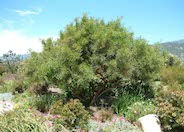
Common name: African Sumac
Botanical name: Rhus lancea
This small, evergreen tree grows slowly to 25' and exhibits an open, spreading habit. Its leaves are dark green, glossy, and divided into 3 willow-like leaflets 4"-5" long. The bark has a dark red color. The tree has males and females. It often has a drooping habit and is prone to Texas Root Rot.
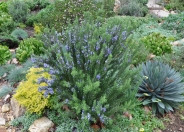
Common name: Ken Taylor Rosemary
Botanical name: Rosmarinus officinalis 'Ken Taylor'
This attractive shrub reaches 3' tall, with arching branches. It can spread 4-5' wide. Evergreen foliage is small, needle-like, green and aromatic. During spring and summer, small dark blue flowers dot the plant, attracting bees. This shrub prefers full sun with well draining soil. Very attractive!
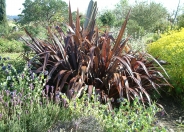
Common name: Rubrum New Zealand Flax
Botanical name: Phormium tenax 'Rubrum'
New Zealand Flax. Burgundy sword-shaped foliage. Deer resistant. Evergreen perennial. Full sun. 3-4 ft. tall and 1-3 ft. wide.
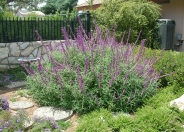
Common name: Mexican Sage
Botanical name: Salvia leucantha
The Mexican Sage is a bushy shrub that grows 3'-4' tall and wide. It has hairy white stems, grey-green leaves and velvet-like purple flower spikes that bloom summer through fall. This shrub tolerates sun, light shade, little water, and is hardy to 15 degrees F. The Mexican Sage attracts hummingbirds. Be careful not to overwater. -Cornflower Farms
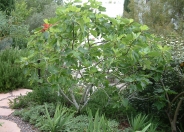
Common name: Edible Fig
Botanical name: Ficus carica
This small tree reaches 20' tall and wide. It does best in rich, fertile, well draining, moist soil with full to part sun. It does not tolerate frost however, there are some cultivars that may survive cold winters. Leaves are deciduous, green and large and lobed. It produces wonderful figs that are green, turning brownish red color in late summer or early fall. Fallen fruit is messy. Mature trees have smooth, silvery bark. Considered invasive in California.
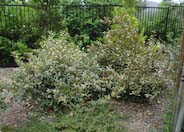
Common name: Fruitland Silverberry
Botanical name: Elaeagnus pungens 'Fruitlandii'
This reliable, evergreen shrub quickly reaches 6'-10' tall and wide. It can be pruned to your liking in winter. Large oval leaves first appear silvery color and then change to olive green with silver dots. Small, fragrant, creamy white flowers appear in fall, followed by brownish red fruit. This shrub tolerates full to part sun with medium to low watering. It is drought tolerant once it's established. It does well in coastal conditions as well as warmer inland areas. Tolerates heat and wind. It can be used as a barrier, for erosion control or hillsides.